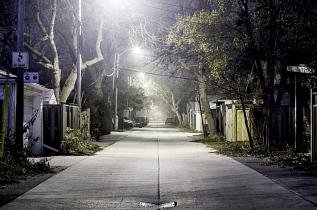Toronto’s Laneways Have Been Overlooked but are Waiting to be Rediscovered: Keenan
I have this recurring dream — apparently it’s very common — in which I open a door in my home and discover new rooms I never knew were there. Sometimes a whole new wing to the house. It always feels like this mysterious and wonderful gift, a new secret place to explore and live and experience.
I sometimes feel the same way, awake, when I wander into a laneway in Toronto. You can be very familiar with a neighbourhood — live or work nearby and walk down the street every day — but suddenly you turn into the gap between buildings and find a whole previously obscured world back there. It’s like there’s a whole bonus city, hiding just out of view of the places you know.
As a child, I spent hours riding my bike around the network of laneways lined with garages and backyards in Riverdale, mapping out secret in-between routes among the houses of my friends, the schoolyards, parks, and churches we knew well. As a young man, my friends and I would seek out after-hours booze cans in lanes behind Yonge and Queen Sts., where the party stretched into the night and the morning. My own children ride their bikes and play ball hockey in a lane we share with our residential neighbours, and also an iron works, an auto mechanic, and a factory.
I always take special pleasure visiting Coach House Press, whose offices and printing shop are housed in B.P. Nichol Lane near U of T. There’s the text of a poem embedded in the concrete outside (“A LAKE A LANE A LINE A LONEâ€), and old-school letterpresses operating inside, a quiet, literary throwback oasis so close to the action of Spadina and Bloor, and yet a world apart.
This in-between city can offer surprises: rows of townhouses in Corktown and Kensington Market and in the shockingly expansive lane north of Dundas St. in the Junction. Sometimes you’ll spot an awning through an alley and discover a bar or shop hidden back there. Rick Mercer made graffiti alley behind Queen St. a famous sight. In one spot north of High Park, I found a sort of private park — a treed lawn, with benches, tucked in the centre of a ring of garages.
It can come to seem that these laneways are an underappreciated aspect of the city. And that as Toronto grows, they are an underused. That might be changing.
The cover story in Now magazine this week explores a push to encourage more laneway housing in the city — especially an effort by Councillors Ana Bailão and Mary-Margaret McMahon for “secondary suites†— the equivalent of basement apartments except in garages on laneways. These apartments would formally be rental spaces serviced with electricity and plumbing and so on from the main property. Still, it’s easy to see how they would add places to live, especially in desirable neighbourhoods that have become expensive.
Meanwhile, the city planning department has included the concept of “mixed-use lanes†downtown in its new Complete Streets Guidelines, published earlier this year. The drawing included envisions a cobblestone lane lined with lampposts that has patios and business entrances on it facing the lane.
It’s an idea that, chief planner Jennifer Keesmaat often mentions, has transformed Melbourne, Australia, where laneway marketplaces have become prime tourist destinations and centres of café society. A laneway marketplace also plays a big role in developer Westbank’s plan for the Honest Ed’s site.
Such initiatives, Keesmaat says, are in line with the thinking behind the Bentway Park being constructed under the Gardiner Expressway, and the plan for a rail deck park in the lands west of Union Station downtown. In a city growing crowded, we need to get creative with looking at how we find and build public spaces. “It’s about being less frivolous with space, thinking about every space as playing a pivotal role in the life of the city.â€
Some existing lanes downtown, she says, are “hard-working†already, serving as delivery and loading areas for businesses. But with others, there’s room to do more — whether it’s “activating†them downtown with more retail and pedestrian uses, or adding residential capacity in less central areas. “It’s a particularly effective way of adding incremental density,†she says. “A significant opportunity to use infrastructure and spaces that already exist.â€
A group called the Laneway Project has been working on demonstration projects around the city to activate laneways in various areas. And the city is working on a pilot project with the same goals.
If such projects are
successful, they seem to have the potential to fulfil that dream of
finding new rooms in the house: spaces that are already there, but that
we’ve overlooked and can discover and use as if for the first time.
Comments
There are 0 comments on this post





